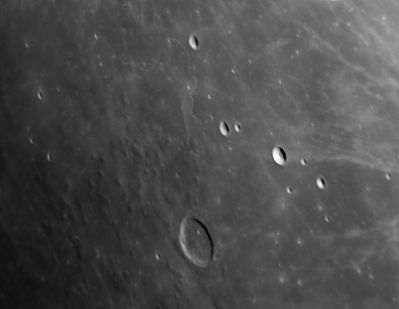Marius
Contents
Marius
|
Lat: 11.88°N, Long: 50.81°W, Diam: 40.09 km, Depth: 1.5 km, Rükl 29 |
Images
LPOD Photo Gallery Lunar Orbiter Images Apollo Images
- AS12-52-7757 shows an oblique orbital view of Marius with extended domefield in the neighbourhood. Research Danny Caes
- Marius was also captured on oblique south-looking Fairchild camera photographs made during the mission of Apollo 15. One of these frames is AS15-M-2610 in which the central part of the frame is occupied by the Aristarchus Plateau and the Vallis Schroteri complex. Southward crater Marius is seen in the distance, at the central part of the curved horizon. Research Danny Caes
Maps
(LAC zone 56B3) LAC map Geologic map
Description
Elger
(IAU Directions) MARIUS.--A very noteworthy ring-plain, 27 miles in diameter, in the Oceanus Procellarum, W.N.W. of Kepler, with a bright border rising about 4,000 feet above the interior, which is of an uneven tone. The rampart exhibits some breaks, especially on the S. The outer slope on the E. is traversed by a fine deep valley, distinctly marked when the opposite side is on the morning terminator. It originates on the S.E. at a prominent crater situated a little below the crest of the wall, and, following its curvature, runs out on to the plain near a large mountain just beyond the foot of the N. border. In addition to the crater just mentioned, there are two smaller ones below the summit of the S. wall, and a small circular depression on the S.W. wall. Mr. W.H. Maw, F.R.A.S., has seen, with a 6 inch Cooke refractor, a bright marking at the N. extremity of the ring, which, when examined with a Dawes' eyepiece, resembled an imperfect crater. The floor includes at least four objects--(1) A crater on the N.E., standing on a circular light area; (2) a white spot a little S. of the centre; (3) a smaller white spot S.W. of this; (4) another, near the inner foot of the S.E. wall. Marius is an imposing object under oblique illumination, mainly because of the number of ridges by which it is surrounded. I have frequently remarked at sunrise that the surface on the E., and especially the outer slope of the rampart, is of a decided brown or sepia tint, similar to that which has already been noticed with respect to Geminus and its vicinity, viewed under like conditions. Schmidt in 1862 discovered a long serpentine cleft some distance N. of Marius, which has not been seen since.
Wikipedia
Additional Information
- IAU page: Marius
- Depth data from Kurt Fisher database
- Pike, 1976: 1.5 km
- Westfall, 2000: 1.5 km
- Viscardy, 1985: 1.67 km
- Cherrington, 1969: 1.67 km
Nomenclature
- Named for Simon Marius (Mayer) (January 10, 1573 – December 26, 1624), a German astronomer. In 1614 Marius published his work Mundus Iovialis describing the planet Jupiter and its moons. Here he claimed to have discovered the planet's four major moons some days before Galileo. This led to a dispute with Galileo, who showed that Marius provided only one observation as early as Galileo's, and it matched Galileo's diagram for the same date, as published in 1610. It is considered possible that Marius discovered the moons independently, but at least some days later than Galileo; if so, he is the only person known to have observed the moons in the period before Galileo published his observations. Regardless of priority, the mythological names by which these satellites are known today (Io, Europa, Ganymede and Callisto) are those given them by Marius.
- A comprehensive new resource on Marius, with lists and links to publications in German, English, French, Italian and Latin is here.
- Marius A, a bowl-shaped crater east-northeast of Marius itself, was called Barangé by Hugh Percy Wilkins and Paluzie-Borrel, but the I.A.U. did not accept that name. Barangé (Albert Barangé Camp) was a Spanish astronomer.
APOD Articles
Marius Hills and a Hole in the Moon
LPOD Articles
The Sad State of Lunar Reference Material Little Hills, Huge Hole
Lunar 100
L42: Complex of volcanic domes & hills.
Bibliography
Marius A ("Barangé"): Wilkins and Moore.
Named Features -- Prev: Mariotte -- Next: Rima Marius
